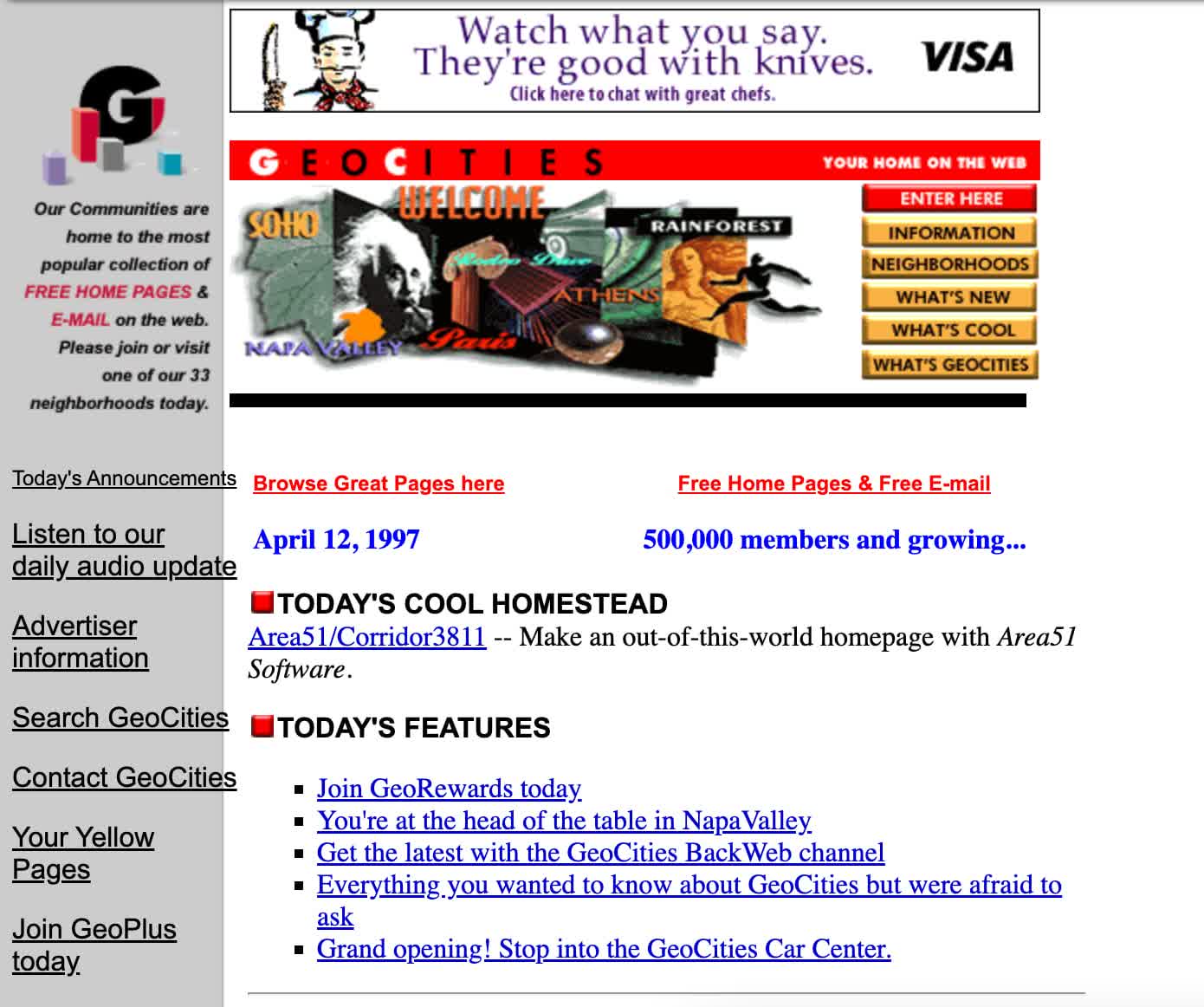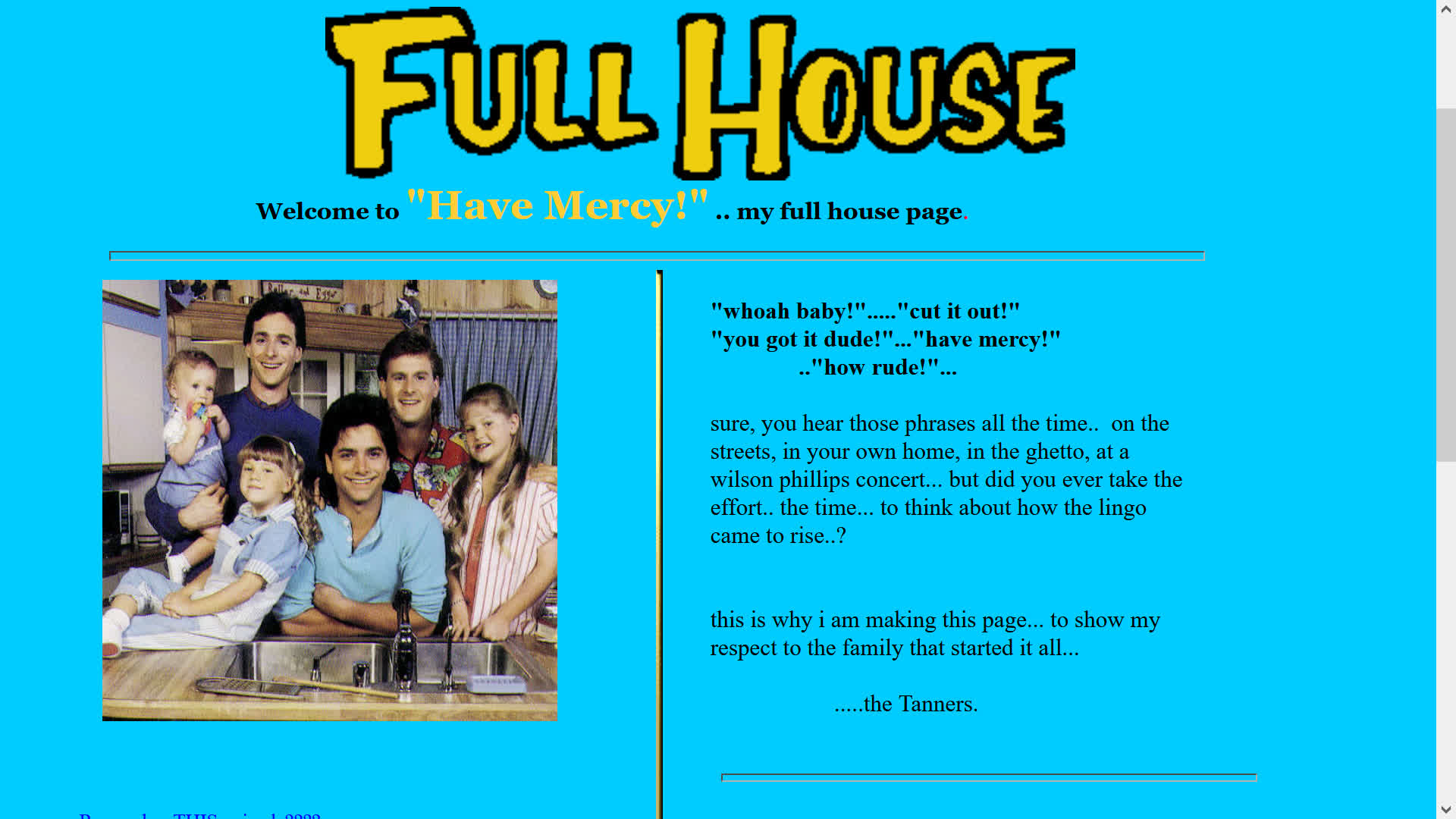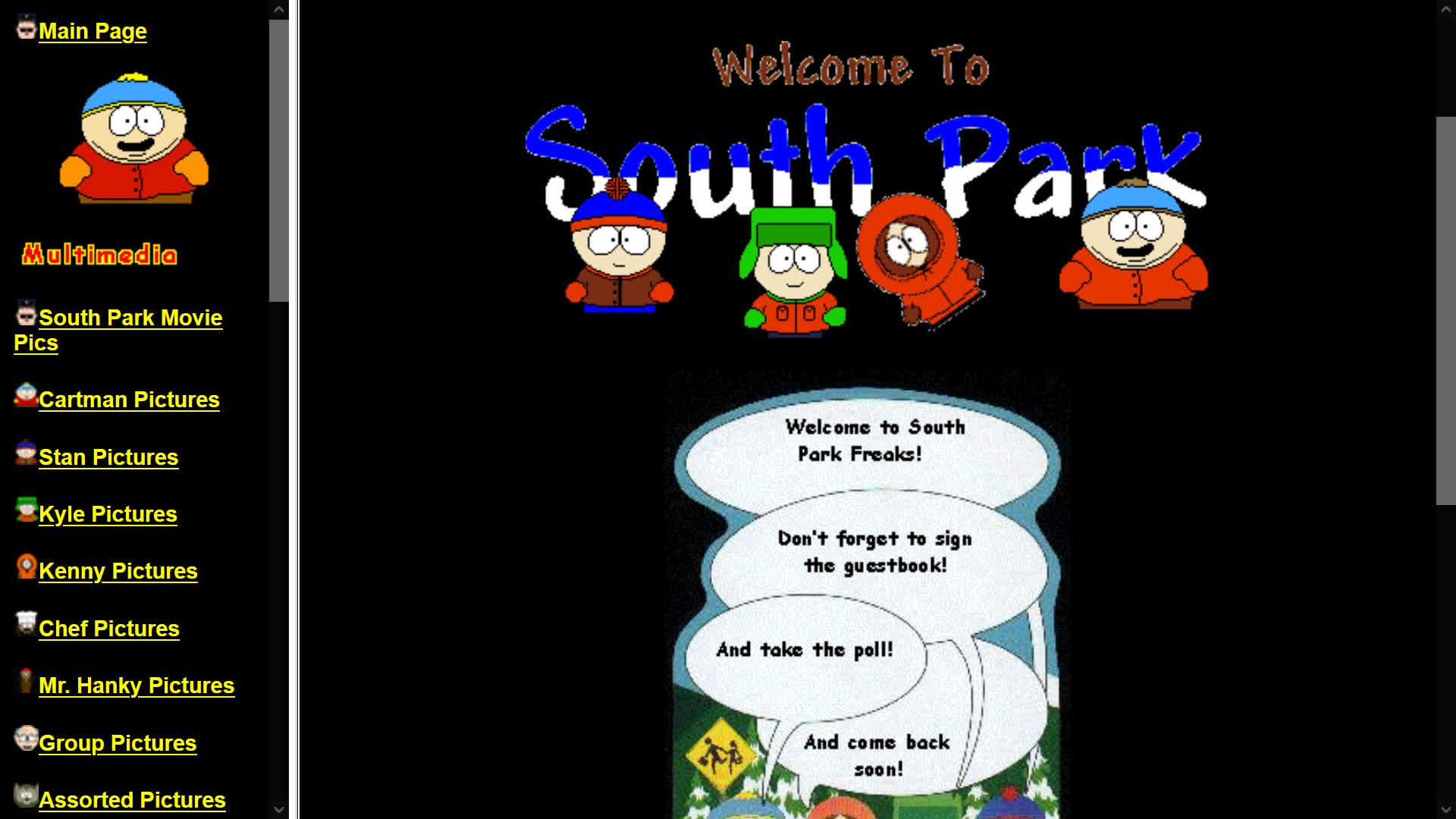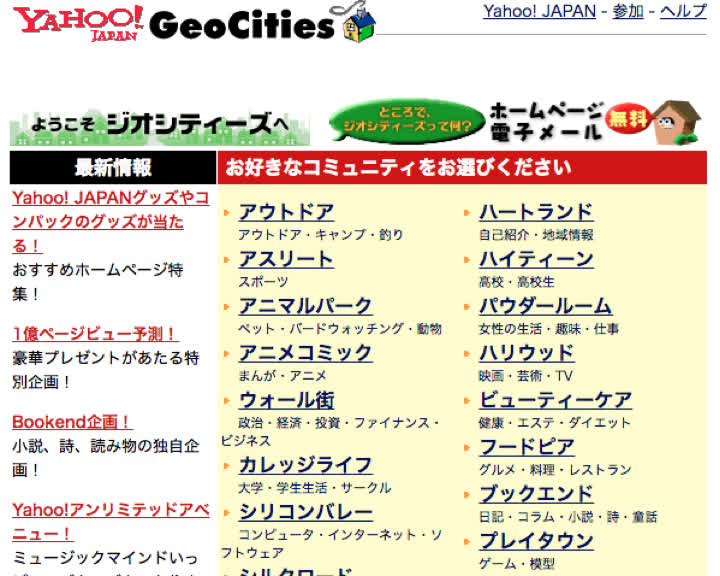What Ever Happened to GeoCities?
In the mid 1990s, the internet had no Facebook, Google or even Wikipedia. If you wanted to use the web to promote your business, share important local information with the rest of the world, or even tell your friends about your recent adventures, you'd need to create your own website.
Most people could learn the basics of HTML coding within a few hours, and starting around 1994, others could use WYSIWYG (what-you-see-is-what-you-get) apps like Adobe PageMill. At one point, even web browsers came bundled with basic website creation tools.

But then the problem was hosting your site online. Servers cost money (especially back then) and not everyone wanted to pay for that service, or could pay for it, if they were teenagers or college students. Enter GeoCities, which started offering a free hosting plan in 1995.

GeoCities was more than just a hosting service, however: with community-oriented features and tools to make the creation of websites easier, it could be seen as the forefather of social media. In 1999, the site was the third-most popular on the web.
At the peak of its popularity, GeoCities was sold to Yahoo!, which drove it away from its social origins, making it irrelevant in the Web 2.0 era. A decade later, it was shut down everywhere outside of Japan. This is the story of an internet that was very different from that of today.

Won't You Be My Neighbor?
GeoCities was started in late 1994 by David Bohnett and John Rezner as just another web-hosting service called Beverly Hills Internet. In June of the following year it started offering a free plan with a generous 2MB of storage space to users, but that was only the beginning.
Users, which were called "homesteaders," were asked to choose a "neighborhood" such as Capitol Hill ("government, politics and lots of strong opinions"), Hollywood ("film and TV") or Paris ("romance, poetry, the arts") upon registration. Neighborhoods, as well as "suburbs" to existing neighborhoods, were added as the site kept growing.

Every neighborhood had its own forum, live chat, and even list of all of the homesteaders that celebrated their birthday each day. The default URL of each site included the name of the neighborhood, and a number, referred to as a "street address."
Homesteaders could either use the site's Basic Home Page Editor to create their site automatically, or upload HTML files, GIF or JPEG images and more. By December 1995, the site had more than 20,000 homesteaders and more than 6 million pageviews per month, when it changed its name to GeoCities.
The success of GeoCities encouraged the appearance of copycat services and website builders. One of those sites called FortuneCity was TechSpot's first home in 1998.
All 'Bout the Money
In 1997, GeoCities started showing pop-up advertisements on its free sites. While annoying to visitors, at least they didn't interfere with the existing designs of websites. The same couldn't be said about the transparent watermark linking to the main site introduced the following year, which would stay at the bottom-right corner of the screen at all times, angering many of the site's 2 million users.
In 1998, the company received $25 million from Japanese holding company SoftBank, and $5 million from Yahoo!. Later that year, it was listed in the Nasdaq stock exchange. The stock launch price was $17, which quickly surpassed the $100 mark as part of the dot-com bubble. The only problem was, the company was still losing money – at the tune of $8 million in the last quarter of 1998, to be more specific.
In 1999, GeoCities was the third-most visited site on the web, and sold to Yahoo! for $3.57 billion in stock, changing its name to Yahoo! Geocities. At first, Yahoo!'s terms of service stated that Yahoo! owned all of the content and rights of GeoCities websites, but that was quickly changed following negative media attention.
Later in 1999, Yahoo! took a step away from the neighborhood-based nature of the site by switching to site URLs based on the user's registration name. By the end of the year 2000, the original neighborhood names were no longer used within the main site either. Those were steps in the opposite direction of where the internet was heading, with groups based on shared interests.

In 2001, Yahoo! introduced premium plans, and imposed a data transfer limit of 4.2MB per hour on free accounts, making it impossible to reach a large audience for free, especially for graphically rich sites. By then, Blogger and Wikipedia were already around.
Myspace, Facebook and Flickr later joined the Web 2.0 revolution, each bringing more reasons not to create or have a personal website. In addition, WordPress launched in 2003, making the site creation and management tools of GeoCities look outdated.
Big in Japan
In April 2009, Yahoo! announced that it would shut down GeoCities in October of that same year, deleting the sites of everyone who hadn't migrated to the paid Yahoo! Web Hosting service, and stopped accepting new members. The only exception was GeoCities Japan, part of Yahoo! Japan, which was a joint venture between SoftBank and Yahoo!

GeoCities Japan remained alive for a decade longer than the main site.
Following the announcement, the Internet Archive launched a project to save as many of GeoCities' 38 million pages as possible. The unrelated Archive Team was also established in response to Yahoo!'s actions, and has since contributed to the preservation of content from several once-popular sites.
In October 2018, Yahoo! Japan, which was no longer related to Yahoo!, announced that GeoCities Japan would finally be terminated in March 2019. The Archive Team then started a new project to preserve the site.
Journey to the Past
If you want to browse old GeoCities sites like you could in the era before the Yahoo! acquisition, based on neighborhoods and suburbs, you should visit Restorativland's GeoCities Gallery.

The SiliconValley neighborhood on the GeoCities Gallery.
If you want to search for a more specific term, you should try GeoCities.ws, a spiritual successor to GeoCities that's completely unrelated to the original company, with a quick-loading archive of GeoCities. The site offers a free hosting service plan under the name "homesteader."
The most thorough archive of old GeoCities sites can be found on OoCities. The site's search function includes results from GeoCities.ws, and you can also search for a site by username, or by neighborhood and "street address."
...
Clearly, GeoCities earned its place in web history.
Discussion topic for the comments: if you were around back in the 1990s, did you have your own website? Or when was the first time you had some presence online?
文章
1
浏览
76586
获赞
5588
热门推荐
Beto O'Rourke livestreamed his haircut. Yes, his haircut.
You can't keep a streaming Beto down.If you didn't think livestreaming a dental appointment was mundTesla update adds Apple Watch connectivity, 'fart on contact' options
Tesla dropped a number of new features, among them was quite useful Apple Watch compatibility. AlsoTrump's Russian income is not being mocked at all. With few exceptions.
Ah yes, with few exceptions, all of us are perfect angels, including Donald Trump. On Friday morningTesla app for Apple Watch hands
Tesla took its sweet time with this one. Given how great the car company’s iPhone app is, oneGoogle Assistant can now use your voice to verify purchases
Making purchases with your voice is convenient, but it's far from secure. Google is attempting to chSleeping woman being wheeled around campus is truly a bizarre sight
Some pictures don't need a full explanation to be funny as hell.SEE ALSO: Watch LInterview with Intel's CEO: Pat Gelsinger describes a different kind of foundry
Something to look forward to:Why has Intel chosen to make the huge strategic pivot and investment toBest Garmin deal: Save $100 on Garmin vívoactive 5
SAVE $100: As of Dec. 20, the Garmin vívoactive 5 is on sale for $199.99 at Amazon. That's a12 interesting gadgets to spice up your self
May is National Masturbation Month, and we're celebrating with Feeling Yourself, a series exploringShep Smith shuts down former Trump advisor for politicizing the Manchester attack
Shep Smith has absolutely no time for people looking to talk politics in the face of tragedy.This beAndrew Garfield channels his inner Whitney Houston in this drag show lipsync battle
Andrew Garfield isn't the first person you'd expect to perform at a drag show. However, the actor isDog desperately trying to catch ball gets the Photoshop battle he deserves
There are some pictures that are simply crying out to be Photoshopped.SEE ALSO: DChunky baby seal born in Japan. Look at him, love him.
There is never a bad time to look at a cute baby animal, so please enjoy this adorable seal.The littSave hundreds during Best Buy's 3
SAVE $300+: During Best Buy's 3-Day Sale, score $75 off a Samsung Galaxy Watch7, $300 off a 14-inchHow to Google Search Like a Pro: Follow These Tips
How many times have you Googled for something, only to find yourself digging through dozens of resul
 科技创新!
科技创新!